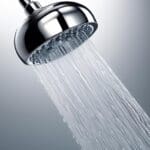Did you know that nearly 85% of households face issues with their shower heads at some point, leaving them searching for alternative ways to rinse shower walls? You’re not alone if you’re in this predicament.
Luckily, there’s a straightforward, five-step method to effectively rinse your shower walls without a shower head. Whether it’s due to maintenance, cleaning, or unexpected malfunctions, you can still keep your shower sparkling clean using tools like a spray bottle, garden hose, or innovative attachments like the Rinseroo.
These steps are not only practical but also ensure you won’t miss a spot, maintaining the hygiene and aesthetic of your bathroom. So, if you’re curious about how to tackle this task efficiently, stay tuned to uncover these simple yet effective techniques that will transform your approach to bathroom maintenance.
Key Takeaways
- Pre-wet walls thoroughly to make cleaning agents more effective and reduce effort
- Apply cleaning solution evenly and let it sit for recommended time
- Use gentle scrubbing techniques and avoid harsh brushes or scrubbers
- Consider alternative rinsing methods like using a bucket or a Rinseroo attachment
Gather Necessary Supplies
Before tackling the task of rinsing your shower walls, it’s essential to gather the right supplies. This includes a spray bottle, hand-held pump sprayer, or a Rinseroo, to ensure an efficient and thorough clean.
A spray bottle or a pump sprayer is perfect for directing clean water precisely where you need it, effectively washing soap scum and residue off the walls. If you’re facing stubborn areas, consider using a solution of equal parts vinegar and hot water. Distilled white vinegar is a powerful ally against grime, and when mixed with hot water in your spray bottle, it can break down even the toughest spots.
Additionally, having a bucket or cup can be handy for rinsing larger sections with clean water, ensuring that no soap or vinegar solution is left behind. For those hard-to-reach areas, a slip-on hose attachment like the Rinseroo can direct water on the walls smoothly and without hassle. Don’t forget a soft bristle brush for gently scrubbing away any remaining build-up.
These tools aren’t only cost-effective but also versatile, making them valuable additions to your cleaning arsenal for various tasks around your home.
Pre-wet the Walls
To effectively loosen dirt and grime, start by thoroughly pre-wetting the shower walls with clean water using a spray bottle or a small hand-held pump sprayer. This initial step is crucial for a successful cleaning process. By ensuring the walls are completely damp, you’re not just making the cleaning agents more effective; you’re also reducing the effort needed to scrub away buildup. It’s the best way to prepare the shower for a deep clean, ensuring that every inch of the walls can be easily accessed and treated.
Moreover, pre-wetting helps to prevent streaking. When you evenly distribute water across the surface before applying your cleaning solution, you ensure a uniform application. This means that once you get to the rinse phase, you’ll find it easier to wash away suds and residue, leaving behind sparkling clean walls without unsightly marks.
Remember to use clean water for this step. Contaminated or dirty water can spread more grime across the walls, counteracting your cleaning efforts. Once the walls are fully wet, you’re ready to move on to applying your chosen cleaning solution. If you’re in a pinch and don’t have a sprayer, don’t hesitate to use a bucket to splash water over the walls. It’s all about ensuring the surface is prepped and ready for a thorough clean.
Apply Cleaning Solution
After ensuring the shower walls are thoroughly wet, it’s time to apply the cleaning solution that will tackle dirt and grime effectively. Fill a spray bottle or a small hand-held pump sprayer with your chosen cleaning solution. This solution should be suitable for the material of your shower walls, whether it’s tile, glass, or another surface.
Spray the cleaning solution evenly across the shower walls, making sure you achieve complete coverage. This step is crucial for ensuring every inch of the wall gets cleaned. Allow the solution to sit for the recommended amount of time. This waiting period lets the cleaning agents work their magic, breaking down soap scum, hard water stains, and general grime.
Next, grab a sponge, clean cloth, or a soft bristle brush to gently scrub the walls. Pay special attention to areas with stubborn stains or buildup. If you encounter particularly tough spots, consider using a paste made from baking soda and white vinegar, and apply it with a bit more elbow grease.
Scrub Thoroughly
Once you’ve applied the cleaning solution, grab a sponge, cloth, or soft bristle brush and start scrubbing the shower walls thoroughly to remove dirt and grime. It’s crucial to use a cleaner designed for bathrooms to ensure effectiveness without damaging surfaces. For best results, make tight, circular strokes with your tool of choice. This technique helps lift and eliminate stubborn buildup, including hard water spots and soap scum, with precision.
Avoid hard bristle brushes and metal scrubbers, as these can scratch and damage the delicate finish of your shower walls. Instead, opt for a soft-bristled brush or an old toothbrush for areas that require detailed attention, such as grout lines and corners. This approach ensures a deep clean without risking the integrity of your shower surfaces.
To clean the shower door, apply the same principles. Use a soft cloth or sponge with your cleaning products to scrub thoroughly, paying special attention to any spots or buildup. Regular scrubbing not only maintains the cleanliness and shine of your shower but also prevents the need for more intense deep cleaning sessions in the future, keeping your shower looking pristine with minimal effort.
Rinse Using Alternative Methods
Having scrubbed your shower walls thoroughly, it’s crucial you now focus on effectively rinsing away the residue without a standard shower head. Fortunately, there are several alternative methods you can use that are both practical and efficient.
Firstly, a cup or bucket filled with water works wonders. Simply fill it up, and use that to rinse the walls. This method allows you to target specific areas, washing away soap and grime directly into the drain. It’s an easy way to control the flow and prevent excess water from pooling in areas you’ve already cleaned.
For those looking for a more hands-off approach, consider attaching a garden hose or using a Rinseroo. These tools provide a steady flow of water, making it easier to shower with water all the shower walls without the need for constant refilling. Turning on the water, you can efficiently wash away all the residue in one go.
Lastly, investing in a handheld shower or a removable showerhead offers the ultimate flexibility. Not only do they provide better control and coverage, but they’re also incredibly convenient for other cleaning tasks. This versatility makes them a practical addition to any cleaning arsenal.
Frequently Asked Questions
How Do You Rinse a Shower Without a Shower Head?
To rinse your shower without a shower head, you can use a spray bottle, a hand-held pump sprayer, or attach a garden hose. These methods provide a controlled spray or steady flow for effective rinsing.
Can You Use a Shower Without a Shower Head?
Yes, you can use a shower without a shower head. Try using a spray bottle, a hand-held pump sprayer, or attaching a garden hose. These methods are cost-effective, convenient, and great for cleaning tasks.
How Do You Rinse a Standing Shower?
To rinse a standing shower, grab a spray bottle or hand-held pump sprayer filled with water. Aim and spray down the walls thoroughly. For larger areas, consider using a Rinseroo or garden hose for efficiency.
How Do You Deep Clean Shower Walls?
To deep clean your shower walls, first, mix a cleaning solution of water and heavily diluted white vinegar. Apply it generously, scrub with a brush, then rinse thoroughly using a spray bottle or a hand-held pump sprayer.





